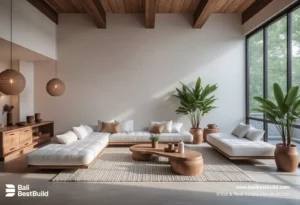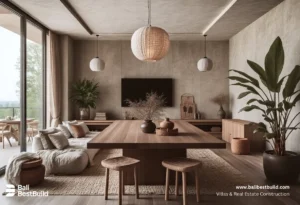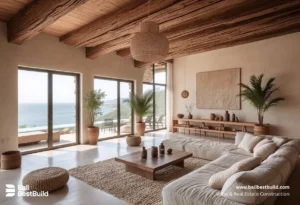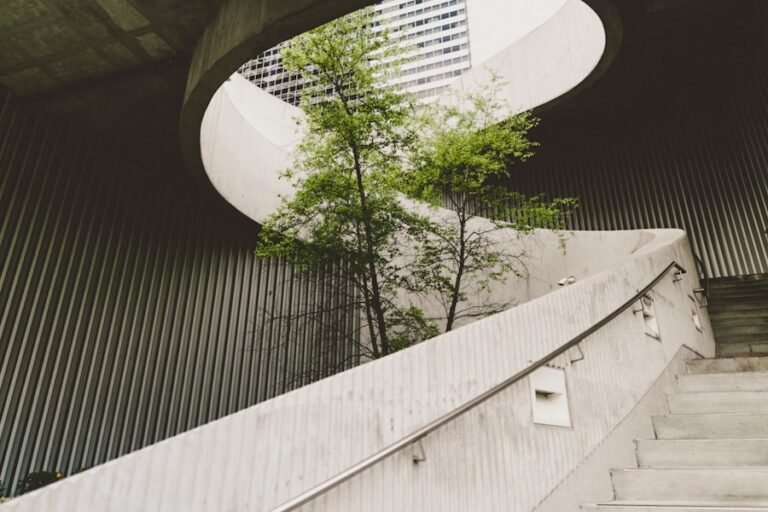Bali, known for its stunning natural beauty and rich cultural heritage, has seen a surge in construction and development in recent years. With this growth comes the need for sustainable construction practices to preserve the island’s natural resources and cultural identity. Sustainable construction in Bali focuses on minimizing the environmental impact of building projects, using locally-sourced materials, and incorporating renewable energy sources. This approach not only benefits the environment but also supports the local economy and community. As the demand for sustainable construction continues to grow, it is essential to understand the traditional building techniques and materials used in Bali, as well as the incorporation of renewable energy sources, waste management, community involvement, and government policies and incentives that support sustainable construction practices.
Traditional Balinese Building Techniques and Materials
Traditional Balinese building techniques and materials have been used for centuries and are deeply rooted in the island’s culture and traditions. One of the most iconic features of Balinese architecture is the use of bamboo, a versatile and sustainable material that is abundant on the island. Bamboo is used for various purposes in construction, including as a structural element, wall cladding, and roofing material. Another traditional building technique is the use of alang-alang grass for thatched roofs, which provides natural insulation and ventilation. Additionally, Balinese builders often use locally-sourced stone and wood, such as volcanic rock and teak, to construct buildings that blend seamlessly with the natural landscape. These traditional techniques and materials not only contribute to the unique aesthetic of Balinese architecture but also promote sustainability by reducing the need for imported materials and minimizing environmental impact.
In addition to traditional materials, Balinese builders also utilize age-old construction techniques that prioritize sustainability. For example, the “subak” system, a traditional irrigation method used in rice terraces, has been adapted for sustainable water management in construction projects. This system emphasizes the efficient use of water resources and promotes harmony with the natural environment. By incorporating these traditional building techniques and materials into modern construction practices, builders in Bali can create sustainable structures that honor the island’s cultural heritage while minimizing their environmental footprint.
Incorporating Renewable Energy Sources in Construction
In recent years, there has been a growing emphasis on incorporating renewable energy sources into construction projects in Bali. The island’s abundant sunshine and strong winds make it an ideal location for harnessing solar and wind energy. Many sustainable construction projects in Bali now include solar panels to generate electricity and solar water heaters to provide hot water for buildings. Additionally, wind turbines are being installed to harness the power of the island’s coastal breezes. By utilizing these renewable energy sources, construction projects can reduce their reliance on fossil fuels and decrease their carbon footprint.
Furthermore, sustainable construction practices in Bali also prioritize energy-efficient design and passive cooling techniques to minimize the need for artificial cooling systems. This includes orienting buildings to maximize natural ventilation, using shading devices to reduce heat gain, and incorporating thermal mass materials to regulate indoor temperatures. By integrating these strategies into construction projects, builders can create energy-efficient structures that are comfortable and environmentally friendly. As the demand for sustainable construction continues to grow in Bali, the incorporation of renewable energy sources will play a crucial role in reducing the environmental impact of building projects while promoting a more sustainable future for the island.
Waste Management and Recycling in Construction Projects
Waste management and recycling are essential components of sustainable construction practices in Bali. With the increase in construction activity on the island, there is a growing need to minimize waste generation and promote recycling efforts. Builders are now implementing strategies to reduce construction waste by using prefabricated materials, optimizing material usage, and implementing on-site sorting and recycling programs. Additionally, many construction projects are incorporating recycled materials into their designs, such as reclaimed wood, recycled glass, and repurposed metal, to minimize the demand for new resources.
Furthermore, sustainable construction projects in Bali are prioritizing the use of low-impact materials that are non-toxic and recyclable. This includes using eco-friendly paints, adhesives, and sealants that have minimal environmental impact. By prioritizing waste management and recycling efforts, construction projects can minimize their contribution to landfills and reduce their overall environmental footprint. As Bali continues to embrace sustainable construction practices, waste management and recycling will play a crucial role in preserving the island’s natural beauty and promoting a more circular economy.
Balinese Community Involvement in Sustainable Construction
Community involvement is a key aspect of sustainable construction in Bali, as it fosters a sense of ownership and pride in building projects while promoting social sustainability. Many sustainable construction projects in Bali prioritize local community engagement by hiring local labor, sourcing materials from nearby suppliers, and involving community members in the design and planning process. This not only supports the local economy but also ensures that building projects are culturally sensitive and respectful of traditional practices.
Furthermore, community involvement extends beyond the construction phase, as many sustainable projects aim to create long-term benefits for local residents. This includes providing training and education opportunities for community members to learn about sustainable building techniques, promoting job creation through green construction initiatives, and supporting community-led initiatives that prioritize environmental conservation. By involving the Balinese community in sustainable construction projects, builders can create structures that are not only environmentally friendly but also socially responsible and culturally relevant.
Government Policies and Incentives for Sustainable Construction
The government of Bali has recognized the importance of sustainable construction practices and has implemented policies and incentives to support green building initiatives on the island. In recent years, there has been a push to promote sustainable development through regulations that prioritize energy efficiency, water conservation, waste management, and green building certifications. Additionally, the government offers incentives such as tax breaks, grants, and subsidies for builders who incorporate sustainable practices into their projects.
Furthermore, the government has established partnerships with international organizations and NGOs to promote sustainable construction practices and provide technical assistance to builders. These initiatives aim to raise awareness about the benefits of sustainable construction while providing resources and support to help builders implement green building strategies. As a result of these government policies and incentives, there has been a significant increase in sustainable construction projects in Bali, demonstrating the positive impact of policy support on promoting environmentally friendly building practices.
Case Studies of Successful Sustainable Construction Projects in Bali
Several successful sustainable construction projects in Bali serve as inspiring examples of how green building practices can be integrated into the island’s development. One notable case study is the Green School Bali, an innovative educational institution that was built using sustainable materials such as bamboo, recycled ironwood, and alang-alang grass for its iconic roof structures. The school also incorporates renewable energy sources such as solar panels and utilizes passive cooling techniques to minimize its environmental impact. Another example is Bambu Indah, a boutique eco-resort that features unique bamboo structures designed with sustainability in mind. The resort utilizes rainwater harvesting systems, solar power, and composting toilets to minimize its ecological footprint while providing a luxurious experience for guests.
Additionally, there are numerous residential and commercial developments in Bali that have embraced sustainable construction practices, including eco-friendly villas, green hotels, and environmentally conscious office buildings. These case studies demonstrate that sustainable construction is not only feasible but also economically viable and aesthetically appealing. By showcasing successful examples of green building projects in Bali, builders can inspire others to adopt sustainable practices and contribute to a more environmentally friendly future for the island.
In conclusion, sustainable construction practices are essential for preserving Bali’s natural beauty and cultural heritage while promoting a more environmentally friendly future for the island. By embracing traditional building techniques and materials, incorporating renewable energy sources, prioritizing waste management and recycling efforts, involving the local community, implementing government policies and incentives, and showcasing successful case studies of green building projects, Bali can continue to lead the way in sustainable development. As the demand for sustainable construction continues to grow on the island, it is crucial for builders to prioritize environmentally friendly practices that support both the local community and the natural environment. Through these efforts, Bali can continue to thrive as a global leader in sustainable construction while preserving its unique identity for future generations to enjoy.












